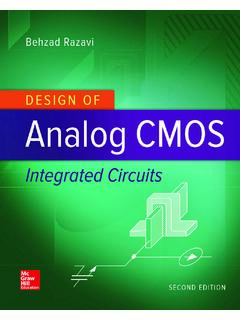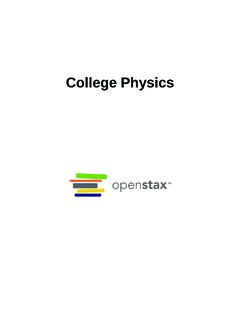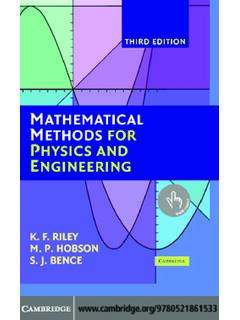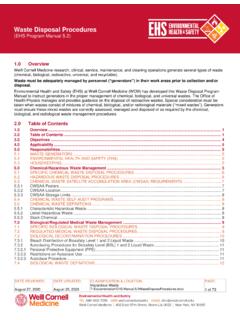Transcription of Fundamentals of Semiconductors: Physics and Materials ...
1 GraduateTextsinPhysicsGraduateTextsinPhy sicsGraduate Texts in Physics publishes core learning/teaching material for graduate- andadvanced-level undergraduate courses on topics of current and emerging fields withinphysics, both pure and applied. These textbooks serve students at the MS- or PhD-level andtheir instructors as comprehensive sources of principles, definitions, derivations, experi-ments and applications (as relevant) for their mastery and teaching, respectively. Interna-tional in scope and relevance, the textbooks correspond to course syllabi sufficiently to serveas required reading.
2 Their didactic style, comprehensiveness and coverage of fundamentalmaterial also make them suitable as introductions or references for scientists entering, orrequiring timely knowledge of, a research EditorsProfessor H. Eugene StanleyBoston UniversityCenter for Polymer StudiesDepartment of Physics590 Commonwealth Avenue, Room 204 BBoston, MA 02215, USAE-mail: William T. RhodesGeorgia Institute of TechnologySchool of Electrical and Computer EngineeringAtlanta, GA 30332-0250, USAE-mail: CardonaFundamentalsof SemiconductorsPhysics and Materials PropertiesFourth of CaliforniaDepartment of PhysicsBerkeley, CA 94720-7300, USAE-mail: Dr.
3 , Dres. Manuel CardonaMax-Planck-Institut f ur Festk orperforschungHeisenbergstr. 1, 70569 Stuttgart, GermanyE-mail: 1868-4513e-ISSN 1868-4521 ISBN 978-3-642-00709-5e-ISBN 978-3-642-00710-1 DOI Heidelberg Dordrecht London New YorkThis work is subject to copyright. All rights are reserved, whether the whole or part of the material isconcerned, specif ically the rights of translation, reprinting, reuse of illustrations, recitation, broadcasting,reproductiononmicrofilmorin anyotherway, thereof is permitted only under the provisions of the German Copyright Law of September 9, 1965, inits current version, and permission for use must always be obtained from Springer.
4 Violations are liable toprosecution under the German Copyright use of general descriptive names, registered names, trademarks, etc. in this publication does not imply,even in the absence of a specif ic statement, that such names are exempt from the relevant protective laws andregulations and therefore free for general on acid-free paperSpringer is a part of Springer Science+Business Media ( ). Springer-Verlag Berlin Heidelberg 1996, 1999, 2001, 2010 LibraryofCongressControlNumber: 2010924732 Preface to the Fourth EditionSince the appearance of our book, Fundamentals of Semiconductors: Physics and Materials Properties, one of the questions we are askedmost frequently is this: is there a solution manual to this book?
5 In preparingthe questions at the end of each chapter we have already tried to guide thereaders to derive the answers by themselves using a step-by-step this strategy did not work for everyone. We recognize that many ofthe questions in this book are quite challenging and often require reading ofresearch papers to solve them. In response to readers demand we have de-cided to provide solutions to some of the problems in this new edition. Sinceworking through problems is an important and necessary part of the learningprocess in Physics we will not give the solutions to all the problems.
6 Instead,we hope to use the solutions to a number of selected problems in each chap-ter as an additional study help to the readers. We like to use these solutionsto provide more in depth discussions to topics which may be too specializedfor a typical course on semiconductor Physics . By leaving enough unsolvedproblems and adding a few new ones there are still plenty of opportunities forboth the instructors to choose problems for assignments and for students totest their understanding of the text. We like to point out that, even if the solu-tion can be found in this manual , there is usually more than one way to solvea given problem.
7 Conscientious students should always ask whether there is abetter way to solve a problem than the one we have provided in this new addition also allows us to update and expand some topics andreferences. Finally, we hope to have taken care of the few errors still remain-ing in the third edition. We like to use this opportunity to thank the readerswho have identified them to us. Their support has been invaluable in our ef-fort to improve this Russian translation of our book has appeared in 2003. It joins previ-ous translations of the book into Japanese and Chinese, making this bookavailable to a truly international readership.
8 Last, but not least, the home-page of the book has been given a face lift . Readers are encouraged tovisit the new website at: discover new information and Materials which have been Y. Yu and M. CardonaBerkeley, CA and Stuttgart, GermanyMarch 2010 Preface to the Third EditionThe support for our book has remained high and compliments from readersand colleagues have been most heart-warming. We would like to thank all ofyou, especially the many students who have continued to send us their com-ments and suggestions. We are also pleased to report that a Japanese transla-tion appeared in 1999 (more details can be obtained from a link on our Website: ).
9 Chinesea)and Russian translationsare in Physics and material science have continued to prosper andto break new ground. For example, in the years since the publication of thefirst edition of this book, the large band gap semiconductor GaN and relatedalloys, such as the GaInN and AlGaN systems, have all become important ma-terials for light emitting diodes (LED) and laser diodes. The large scale pro-duction of bright and energy-efficient white-light LED may one day changethe way we light our homes and workplaces. This development may even im-pact our environment by decreasing the amount of fossil fuel used to produceelectricity.
10 In response to this huge rise in interest in the nitrides we haveadded, in appropriate places throughout the book, new information on GaNand its alloys. New techniques, such as Raman scattering of x-rays, have givendetailed information about the vibrational spectra of the nitrides, availableonly as thin films or as very small single crystals. An example of the progressin semiconductor Physics is our understanding of the class of deep defect cen-ters known as the DX centers. During the preparation of the first edition, thephysics behind these centers was not universally accepted and not all its pre-dicted properties had been verified experimentally.








